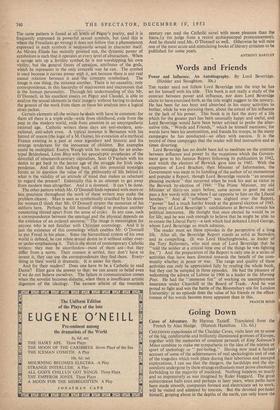Going Down
Caves of Adventure. By Haroun Tazieff. Translated from the French by Alan Hodge. (Hamish Hamilton, 12s. 6d.)
CHILDHOOD experiences of the Cheddar Caves, visits later on to some of the big, comfortable and brilliantly illuminated grottoes of Europe, together with the memories of constant perusals of King Solomon's Mines combine to make me sympathetic to the idea of the science or sport of speleology or " pot-holing." Having now read a factual account of some of the achievements of real speleologists and of one of the tragedies which took place during their laborious and intrepid explorations, I can see that the dangers, the hardships and the dis- comforts undergone by these strange enthusiasts must prove absolutely forbidding to the majority of mankind. Nothing happens so neatly and so impressively as was imagined by Rider Haggard. The great subterranean halls exist and perhaps in later years, when paths have been made smooth, companies formed and electricians set to work, will be visited and admired by tourists. But the devoted pot-holer himself, groping about in the depths of the earth, can only know the
pleasure of discovering something which, since not much equipment can be carried and flares have to be used sparingly, he can hardly even see.
It appears, however, that, in spite of the appalling hardships faced and what seem to an outsider the meagre rewards obtained, the speleologist himself has the same passionate enthusiasm for going down as the mountaineer has for going up. In some respects he has an advantage over the mountaineer, for more remains obscure below than upon the surface of the earth. And he may certainly claim to be more useful than the-mountaineer. The climbers of Everest can photograph the foot-prints of the abominable snowman, but the speleologist can discover, according to M. Felix Trombe, who contributes a preface to M. Tazieff's book, " minute fauna belonging to innumerable species .... These tiny cave-dwelling creatures are really the greatest lords on earth, for they can trace their pedigree back to ancestors that have now disappeared and whose fossil remains are to be found in the oldest of lands." Then, too, there are the practical uses which science can make of the underground rivers and falls which the speleologist discovers. Such discoveries are, writes M. Trombe, " capable of changing the hydro-electric facilities and the economic development of an entire region."
Yet one suspects that the true speleologist undergoes his great hardships, not so much for the benefit of mankind or the progress of science as because, for some extraordinary reason, he likes doing these things. Among the many excellent photographs with which M. Tazieff's book is illustrated there is one in particular of Marcel Loubens, who, it will be remembered, most tragically lost his life in the expedition which this book records. Loubens is shown sitting down beside an underground river 480 metres below the surface. There is darkness all round him, but the light shines on a small stretch of tumbling water and on a fragment of rock. The expression on Loubens's face is one of ecstatic joy. Not many hours after this photograph was taken Loubens was killed owing to a defect in the apparatus which was to draw him up to the surface. It is clear, not only from the photograph but from the whole record of hig achievement, that he had not been risking his life for something which was to him without great value. The delight in discovering the unknown is something which, in one way or other, affects all men, and something new and tremendous, glimpsed for a moment in the light of a flare, must be for the speleologist the motive of his activity and the reward for his endeavour. He never knows, as he struggles about amongst piles of boulders, marking his route through the darkness with illuminated strips of cloth, when there will break upon his ears the sound of falling water which will denote the dis- covery of a new river, or, as at the end of a tunnel he lights his flare, whether he may not find himself in some gigantic cavern, adorned with stalagmites and stalactites which flash upon his senses briefly and are gone. At such moments the scientific speleologist may talk in terms of kilowatts and cubic metres ; but his real pleasure, I believe, is in something different. He has done and seen something or other which has never been done or seen before.
The actual achievements of the expedition which M. Tazieff records have been extended this year, as has been reported in the Press. And no doubt more still will be discovered in the caves of Pierre Saint-Martin and elsewhere. But the story of this particular expedition must be particularly remarkable because of the dying of
Loubens and because of those, strictly speaking, extraneous human qualities which were involved in or called forth by that death. M. Tazieff has succeeded in telling the story. One regrets slightly that he has not allowed the story to speak more for itself. Ho conveys, certainly, an impression of reality and this reality is very moving. But much of the semi jocular dialogue is inept, and, though one is grateful indeed for the record, one is left with the wish that the book had either been longer and better written, or, though it is not long, rather shorter.
REX WARNER











































 Previous page
Previous page